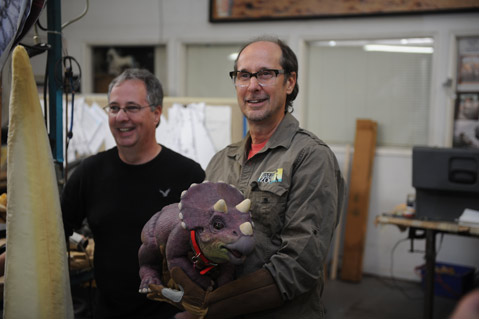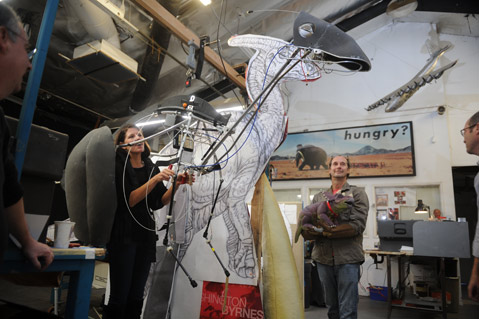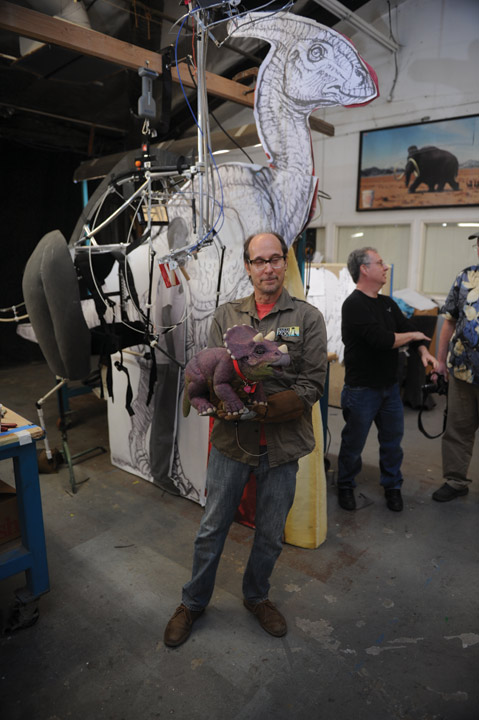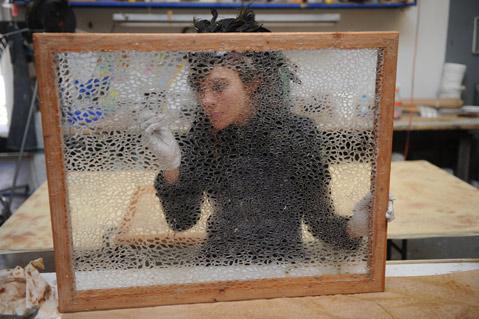It’s a Dino’s World
How Burbank's Chiodo Brothers Are Making Dinosaurs the Stars of the Santa Barbara Zoo

Two years ago, egged on by a crowd of eager children, an extinct reptile named Duncan reared his toothy head from behind a wooden fence, and the Santa Barbara Zoo hasn’t been the same since.
Duncan, you see, is a 15-foot-long, human-powered Tyrannosaurus rex puppet that, in May 2011, became a regular fixture of the zoo’s programming, translating kids’ inherent dinosaur fascination into lessons about how zookeepers brush gorilla teeth and deal with animal poop. Built especially for the zoo by the renowned Chiodo Bros. special effects studio in Burbank, Calif., Duncan immediately filled an educational entertainment vacuum historically occupied by zoo residents — any of the anthropomorphic tricks with cuddly and/or carnivorous animals still pulled on late-night talk shows, or chimpanzees dressed up for a tea party, for instance — and made it easier, safer, and, many would agree, better for both the audience and the zoo. Today, if my 3-year-old son and his countless zoo-going peers are any indication, Duncan is probably the number one attraction for elementary school–aged children at the second most popular spot on the entire Central Coast of California. (The zoo’s nearly 500,000 annual visitor count is only trumped each year by Hearst Castle.) And that just might make him the most desired dino on the planet.

But Duncan — whose 75 pounds of metal skeleton, sculpted foam, and specially designed skin are hoisted onto the shoulders of a trained actor for each show — is getting tired. “He had three shows a day last summer, and when you’re how many millions of years old, that’s tough; that’s a lot for a dinosaur,” said the zoo’s head honcho, Richard Block, explaining that Duncan’s expected three-year lifetime, which has already been enhanced with a number of minor surgeries, means a slow fade into the Jurassic sunset sometime in 2014. Filling Duncan’s sizable shoes with a gradual transition that begins next month will be two new Chiodo-made dinos: a 10-foot-tall Parasaurolophus, built to stand erect with similar actor-powered mobility as Duncan, and a much smaller blinking baby Triceratops, which is handheld and portable, allowing for more up-close showing off, as well as offsite zoo outreach.

I learned as much while Block drove me south to meet up with the Chiodo bros themselves, a trio originally from the Bronx who moved to Los Angeles in the 1980s to be filmmakers, but became experts in special effects, costume creation, and puppetry. They came on the zoo’s radar a few years back, when Block and marketing director Dean Noble, whom we pick up in the Conejo Valley, were brainstorming new programming. They had several dinosaur exhibit options in front of them, but all were both pricey and temporary. One day, Noble’s wife asked why they didn’t just have a dino made especially for the zoo? Around that same time, Noble serendipitously met the Chiodos at a zoo fundraiser. Duncan’s gestation began shortly thereafter.
From the outside, the Chiodo Brothers’ studio on a backwater Burbank street near Interstate 5 looks like a small plant nursery, but once inside, it’s an eye-popping emporium of familiar monster faces, furry creatures, and puppets both tiny and massive. “We’re filmmakers first, but the films we wanted to make always needed special characters,” said Edward Chiodo, who made Killer Klowns from Outer Space with his brothers in 1988; they have also contributed puppets, clay animation, and other effects to Team America: World Police, Critters, The Simpsons, and Elf, among many other projects. The brothers also once constructed the largest walking dino puppet ever for Universal Studios in Japan, a 23-foot Brachiosaurus that required two actors to operate, including one who was trained to walk backward. “For us, it’s all about the characters,” said Edward, “and we try to figure out the best way to bring that to life.”

In Duncan’s case, the character was a rowdy, adolescent T. rex, but for the second round, the zoo and the Chiodos went a little softer, making the Parasaurolophus into a feminine, motherly character and the tiny Triceratops into a cute baby girl. Like Duncan, the Parasaurolophus will be fully mobile (legs, arms, jaw, neck, etc.) and outfitted with cameras so that the operator can entertain both a large crowd and individual fans. “It’s important to us that he can come down and address the little kids,” said Stephen Chiodo, who is also proud of the noise-making crest atop the Parasaurolophus’s head, which is what dino experts believe it was used for in ancient times. The Triceratops, meanwhile, is a bright purple puppet with green underbelly that fits easily in Stephen’s arms. “It’s a perfect size, like a baby pig,” he said. “You’ll be able to have really close-up interactions with the audience, and you can take it to clubs, organizations, and classrooms.” As for names, the Parasaurolophus will be known as Lily, a reference to the former owner of the zoo property, Lillian Child, as suggested by donor J. Carol Duncan (of Rusty’s Pizza fame, for whom Duncan the dino was named); the public is encouraged to suggest names for the baby tri via the zoo’s Facebook page.
Of course, dinosaur puppetry isn’t for everyone, as the actors will have to be at least 510 to operate the Parasaurolophus, though it only weighs 50 pounds, about 25 less than Duncan. Plus, explained Edward, “It’s claustrophobic, hot, and very sweaty. It’s pretty intuitive — you know pretty quickly whether you’re up for it or not.”
The zoo’s dinosaur projects pushed the Chiodos to innovate in both puppetry mechanics and the development of the dino’s special skin, which is a silica spandex material with a tactile feel and UV coating to protect the coloring. As usual, the Chiodos had to break free from the prescribed mold to do so. “We never follow manufacturer’s recommendations,” said Edward with a childlike grin. “What’s the point?”
Because of their success at the Santa Barbara Zoo, the Chiodos are looking to dino puppets as a new market, making dinos for other places while renting models for birthday parties and other events. “It’s a business we’re looking to build,” said Edward, and that makes sense, given that the Chiodos were first drawn to special effects because, like so many kids, they were fascinated by dinosaurs. “That was the thing that got us into it,” said Edward, “that and King Kong.” And unlike their film work, the rewards of dino puppets are immediately tangible. “We get to see the reaction,” said Edward, “which is great.”
4•1•1
The Santa Barbara Zoo welcomes Lily the Parasaurolophus and the to-be-named baby Triceratops at Member’s Night on Friday, May 10, with weekend shows until school’s out for summer, when daily shows with all three dinos start. See sbzoo.org.



